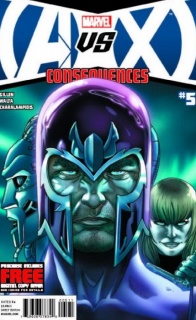What I thought we would get from Marvel was another post-event “fallout” miniseries of little consequence – pardon the pun. As if tacking another “AvX” onto something could be anything other than a cash grab. After all, they did the same thing with “Fear Itself” and it was pretty much more of what readers didn’t want.
Leave it to Kieron Gillen to trounce my expectations.

Written by Kieron Gillen
Illustrated by Gabriel Hernandez Walta– Spinning directly out of AVX #12, find out what happens next!
– We can’t tell you anything else without spoiling everything AVX!
The solicitation says that Marvel can’t spoil AvX, but since that’s all over, let’s talk about where we are. When we last left the convicted Scott Summers, he was about to be broken out of prison by Magneto, Danger, and Magik. Meanwhile, Hope tries to find her place in the world after accomplishing the only thing she was ever working toward and the Avengers try to tie up the loose ends post-Phoenix. Gillen finds fascinating places to go for each of these characters in the wake of “Avengers vs. X-Men.”
By accepting Magneto as a close ally, Scott Summers has gone to the logical conclusion of his character arc since “Schism.” Truly, he and Wolverine have been giving and taking bits and pieces from Xavier and Magneto for as long as they’ve been teammates. Those pieces are finally shaking out, leaving Wolverine in the position that Scott once was and vice versa. Near the end, Scott leaves Logan a note explaining that he knows Wolverine is the mutant to carry on Charles’ vision, while Scott must play the “dark knight” role – to borrow an unfortunate, yet recognizable phrase from another company. The morality dance between Logan and Scott is perhaps the most important and effective character development in Marvel’s modern history and Gillen puts the absolute note-perfect cap on it all.
Gillen is also able to give Hope bittersweet note to end on. Gillen fleshed Hope out in “Generation: Hope” a couple years ago, and his return to the character is very nicely played. A visit from Cable resets the dynamic between the two characters and assures us that she’ll be an important factor in future Marvel stories, without leaving yet another pesky cliffhanger to worry about.
Being a weekly miniseries, each issue has had a different artist. Thus far, this had worked really well. Guys like Tom Raney, Steve Kurth, & Mark Brooks gave their issues a consistent sort of “house” style to their contributions (though I hate the term “house style”). What we get from Walta is jarringly different and just too stylized to work with this series. He has some successful moments, such as the page that shows all of Hope’s exploits around Chicago in a briskly-paced set of flashbacks and the monstrous destruction that Scott’s jailbreak entails. Other moments, frankly, don’t work well at all. The Avengers themselves look silly in almost every one of their appearances. Captain America and Thor look like goofballs next to characters with subtler costumes, like Spider-Woman and Captain Marvel, whom Walta handles much better. The script in “AvX: Consequences” #5 is so tremendous – I can only imagine how much more impactful the final page could have been with a more bravura art style.
It’s a shame, because this book really does deserve a read. In 5 issues, Kieron Gillen has done nothing less than give a more interesting context and depth to the “Avengers vs. X-Men” event than the entire 12-issue miniseries did itself. The characters sound truer to themselves, the plotting was less scattershot, and the themes that the writer is working with are explored with far more subtlety. You can either attribute this to having one writer vs. many or to the point that Kieron Gillen is perhaps Marvel’s most consistent writer.
Either way, this is a book that is not to missed. It catches the reader up on everything they need to know from “AvX”, puts it into context, and gets us all ready for whatever lies ahead in Marvel NOW!
Final Verdict: 7.3 – Buy. Not the strongest art, but a fine ending for a great mini.



